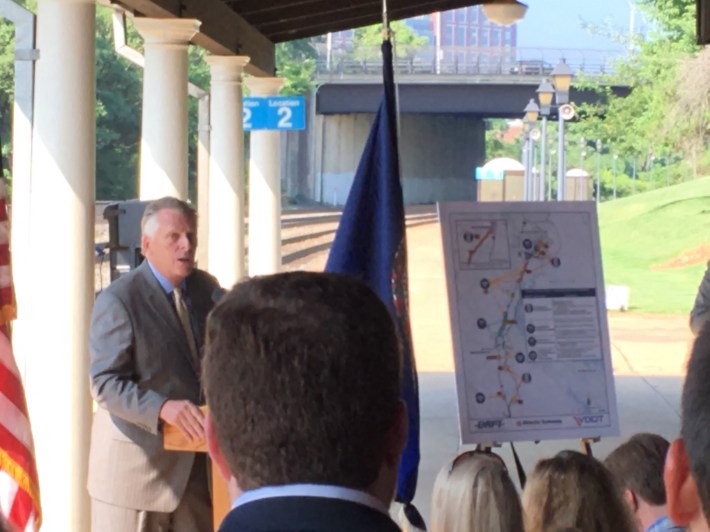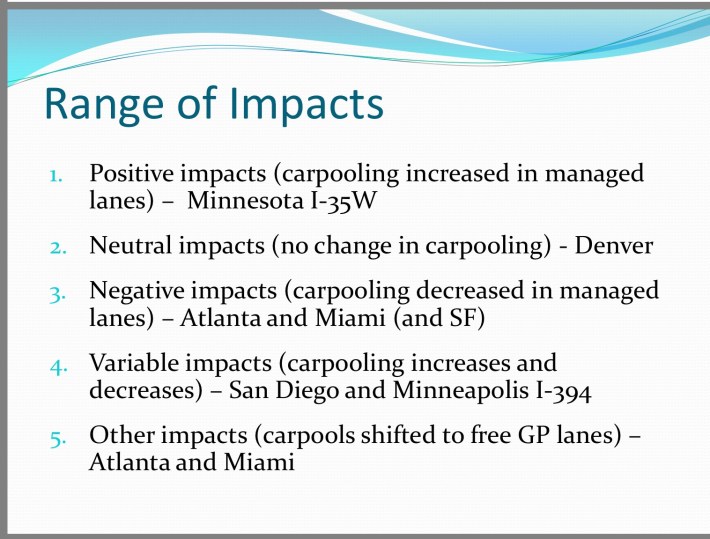The Mythology of HOT Lanes
2:24 PM EDT on September 27, 2016
In July Virginia Governor Terry McAuliffe stood on the platform of a train station in Alexandria to announce that the U.S. Department of Transportation had granted $165 million for the Atlantic Gateway project.
While this is a multimodal project featuring rail, bus, and highway improvements, it was clearly the latter that most enthused the governor. At one point during his remarks, he declared that because of the road projects, “Today, the congestion is going to end!”
The primary focus of the highway improvements will be an extension of the HOT (high occupancy toll) lanes on I-95 and I-395. The only other speaker after the governor was a representative from Transurban, the controversial company that will operate the extended toll lanes.
Is McAuliffe right to be so confident in the ability of HOT lanes to eradicate congestion? Let’s look at three key arguments often heard in favor of HOT lanes.
Argument 1: Adding HOT lanes reduces congestion in general lanes along the same route.
According to the Federal Highway Administration, HOT lanes -- sometimes branded as “express” or “managed” lanes -- pull users from the general lanes because they stay uncongested. As usage of the HOT lanes increases, the toll increases. That keeps those who don't want to pay the higher toll from entering. If enough drivers leave the general lanes for the toll lanes, the general lanes will move more freely.
This argument overlooks the phenomena of induced demand: as capacity increases, traffic also increases, as measured by vehicle miles traveled. The California Department of Transportation, Caltrans, acknowledged this effect could neutralize capacity expansions within five years.
It may not take that long. In Houston, Texas, commuters have discovered that having the world’s widest expressway that includes HOT lanes is no permanent congestion cure. The Katy Freeway is now a staggering 23 lanes wide, but three years after the state allocated $2.8 billion to expand it, congestion returned to its original level and continues to grow.
Though HOT lanes don't prevent bottlenecks from occurring at toll lane exits, lane extensions are usually justified as an effort to eliminate them -- just as highway expansions are typically justified. But no expressway or HOT lane can deliver drivers directly to their destination, and at some point there will be a bottleneck. This is the scenario now playing out in northern Virginia, just as it has after every previous expansion of I-95.
If HOT lanes do not relieve congestion in the long term, how do politicians and planners justify them? Consider this statement [PDF] from the Washington State Department of Transportation, in a study on Miami HOT lanes used to promote a WSDOT project: “95 Express has improved overall traffic conditions along the project corridor since its inception.”
The WSDOT study, however, only looked at the first two years of Miami data -- and even that shows travel speeds were already dropping by year two. A review of figures compiled by Caltrans [PDF] from the Katy Freeway, I-95 in Miami, and Georgia’s I-85 shows that short-term data are often cited to sell a HOT lane project.
Argument 2: Converting HOV (High Occupancy Vehicle) lanes to HOT lanes doesn’t increase overall congestion in those lanes.
The sight of HOV lanes sitting mostly empty during rush hour has proven irresistible to commuters, politicians, and planners, especially in a time of limited infrastructure budgets. When the Reason Foundation pitched the concept of converting HOV lanes into HOT lanes, it claimed: “In most cases the conversion of an existing HOV lane to a HOT lane should be more than self-supporting from the new toll revenues.”
Critical to justifying a conversion is showing that current HOV users, such as buses and carpools, won’t be adversely impacted by the addition of paying users. In Reason [PDF], Robert W. Poole Jr. and C. Kenneth Orski recommend a data-driven approach to downplaying this risk:
The analytical case may involve computer modeling to show that overall traffic flow will be improved in the corridor in question, reducing the extent of stop-and-go traffic (and hence, reducing running emissions) in the existing lanes while guaranteeing the smooth flow of traffic in the HOT lane.
Citing short-term studies from the 20th century may bias the modeling to yield favorable results. More recent in-depth studies show that traffic does, in fact, slow in reserved lanes after conversion. On California’s I-680 in the southbound reserved lanes, travel speeds dropped significantly [PDF] after the conversion to HOT lanes in 2010. The cost to local, state, and federal taxpayers for this project was $195 million [PDF].
If converting HOV lanes to HOT lanes doesn’t improve vehicle flow, idling isn’t reduced. Idling is considered a cause of CO2 emission, since vehicles must burn gasoline for longer periods than would otherwise be the case in free-flowing traffic. The alleged reduction in idling is an argument used by HOT lane advocates [PDF] in cities that are out of compliance with the Clean Air Act. Evidence indicates that argument is unjustified.
Argument 3. HOT lanes help boost transit use and carpooling.
"High occupancy" implies HOT lanes are for vehicles with more than just one person. According to the HOT lanes marketing toolkit from the U.S. Department of Transportation, “HOT lanes encourage carpooling and other transit alternatives while offering vehicles that do not meet standard occupancy requirements another option for providing more reliable travel times.” However, a 2013 FHWA white paper [PDF] showed that out of HOT lane studies in Minneapolis, Denver, Atlanta, Miami, and San Diego, only Minneapolis saw a clear improvement in carpooling usage. Results in other cities were neutral, inconclusive, or, in the cases of Atlanta and Miami, negative.
Other studies show the negative impact of HOT lanes on carpooling. Researchers at Texas A&M [PDF] found that “…it does appear that carpooling is often negatively impacted by converting a HOV lane to a HOT lane." They continued: “In theory, the added choice of traveling as a SOV on the HOV lane may result in some carpools breaking up.” Researchers at Boston College [PDF] reached the same basic conclusion.
In essence, giving motorists the choice of paying a toll so they don’t have to ride with others encourages single occupant vehicle travel. Does the same effect hurt transit?
Not according to rigorous studies. However, the Center for Neighborhood Technology [PDF] found that, “In practice, many new riders of buses on HOT lanes come from other transit modes and, therefore, do not represent growth in system ridership.” For example, surveys of riders on Miami’s I-95 express lane bus service found that a third of them came from commuter rail. The best that can be said for HOT lanes’ impact on transit use is that it is neutral, though the expenditure of budget resources for no net improvement could certainly be considered a negative.
So, if HOT lanes don’t reduce overall congestion along their routes, worsen congestion in previously existing HOV lanes, and either hurt or fail to improve high occupancy vehicle usage, why build them? Perhaps politicians, desperate to appease angry drivers, are succumbing to a scheme that offers false hope. However, many commuters have begun to lose faith. They are moving to the cities, where they are less dependent on highways to get around. If taxpayer dollars are to be spent effectively, they will have to follow the people.
Stay in touch
Sign up for our free newsletter
More from Streetsblog USA
Friday’s Headlines Got Served
Another day, another GOP lawsuit trying to overturn a Biden administration climate change rule.
Disabled People Are Dying in America’s Crosswalks — But We’re Not Counting Them
The data on traffic fatalities and injuries doesn’t account for their needs or even count them. Better data would enable better solutions.
LA: Automated Enforcement Coming Soon to a Bus Lane Near You
Metro is already installing on-bus cameras. Soon comes testing, outreach, then warning tickets. Wilshire/5th/6th and La Brea will be the first bus routes in the bus lane enforcement program.
Talking Headways Podcast: Charging Up Transportation
This week, we talk to the great Gabe Klein, executive director of President Biden's Joint Office of Energy and Transportation (and a former Streetsblog board member), about curbside electrification.
Why Does the Vision Zero Movement Stop At the Edge of the Road?
U.S. car crash deaths are nearly 10 percent higher if you count collisions that happen just outside the right of way. So why don't off-road deaths get more air time among advocates?







